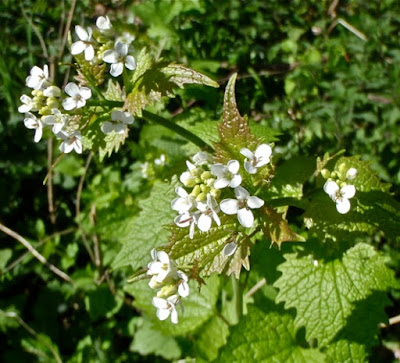April 2021 will be remembered for the relentless block of high pressure over the land, fighting off the weak areas of low pressure bringing warmth and rain. It remained cold with prevailing dry north easterly winds. The surface of the earth was too hard for the usual green shoots to grow and buds on the fruit trees were mostly small and brown, whilst leaf buds on deciduous trees were hardly visible.
The survey for April took place on 27th April with no signs of rain - a bright clear cool start, no wind and hazy high cloud. The lack of wind was welcome allowing some warmth from the sun to touch the surface. The river was still low but flowing well providing a damp habitat along its course and banks, attracting birds, small mammals and insects. Open Willow catkins attracted many Bumblebees and small birds too.
Cuckooflower was growing extensively along the banks together now with Garlic Mustard and more Lesser Celandine . Wild Garlic was flowering everywhere between the trees . It has been a record month for wild flowers growing under trees both in the amount of growth and the long length of time they are lasting. This is most likely due to the delay in trees and shrubs coming into leaf, allowing sunlit glades to last far longer than usual before they become too shady for the flowers to last.
Wild Garlic or Ramsons (Allium ursinum) in flower under bare trees near the river where the ground remained damp.
Later their somewhat overpowering scent would give way to an amazing mixture of scents from various blossoming plants along the river.
Listening to and identifying birds was possible today without any wind roaring through the trees.
Blackbirds (36) were the first to be heard, with most in trees and shrubs whilst many more were foraging on the ground and carrying food to young in the nest. Many House Sparrows were nesting in various sites and taking time out to bathe down low on islands of twigs in the river or take dust baths on the pathways. There were more than ninety (counting the colonies in hedgerows and flying across the river).
Woodpigeons were as numerous as Blackbirds (36), some carrying twigs for nest-building, others bathing in the river which has become a magnet for all wildlife. Eleven carrion crows, one jay and five magpies were visible in the Oaks (not yet in leaf) whilst starlings (25) were for the first time this year circling overhead, catching insects which had formed clouds over the river area between the trees. These would be fed to their young. Herring gulls (8) were in place over the school whilst 5 jackdaws were seen in trees near the copse where a single stock dove was cooing.
Brambles were now throwing out new shoots and a Field Mouse was seen looking out of a dense patch of old brambles.
Garlic Mustard (Allaria petiolara) flowering, quite different from Wild Garlic, with the scent of garlic only when the leaves are crushed. This is a food plant for the Orange-tip butterfly, as is the Cuckooflower.
Loud calls came from an old Oak, still leafless. This was a nuthatch, very visible as were three others in different oaks, their individual territories settled for the spring (4). There were no signs of chaffinch but today a single greenfinch was seen and heard having been seen the previous days well. These are still uncommon, having suffered a population crash some year ago when they were common garden birds.
Fortunately goldfinch numbers are increasing although today only a small colony was present (10).
They are not finding much cover for nesting in the leafless trees.
About the same numbers of robins (25 and wrens (28) were seen today but with several fledged young robins now exploring not far from attentive adults. Many wrens were singing loudly, still guarding their territories on the banks. Four Dunnock were seen, also low on the banks.
Song thrushes (9) were present, some still singing loudly with others seen low down in the as yet sparse undergrowth, foraging for young in the nest. It was interesting to hear 2 mistle thrushes singing, their song carrying far along the riverside.
A single goldcrest was seen flying across to a conifer, and a lone male mallard was seen paddling its way upstream on the Arun.
Blue ts (21) and Great ts (12), some singing, were ranging along the trees and especially the riverside Willows with some swinging on the ends of Hazel branches.
Most of the summer migrants are now here, also ranging along the Willows, with 8 blackcaps, 3 whitethroats, 2 willow warblers and a single garden warbler seen, singing.
The sun had brought out the butterflies, with 6 Peacock butterflies over the dandelions, a Holly Blue around the Lesser Celandines, three Speckled Wood butterflies in a copse and last but not least, at least 26 Orange-tip butterflies- bright males and more subtle females ranging singly along the bramble banks, clumps of Cuckoo flower and Garlic Mustard.

